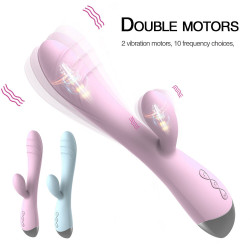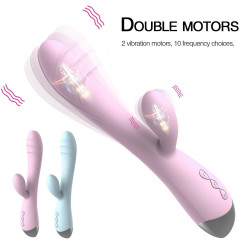
Consensual Non-Consent: What is CNC Kink?
There seems to be no limit to what people are interested in when it comes to discovering sexual quirks. However, that doesn’t mean that some kinks aren’t passionately contested and possibly a little intimidating to ask a partner to participate in. Consensual Non-Consent (CNC) Kink is one of several kinks that you or they might have or just be interested in.
It’s not uncommon to have fantasies about non-consensual and rough sexual activities, whether as the offender or the victim. Consensual non-consent play can allow participants to experience power dynamics that would not be safe in real-life, non-consensual situations if carried out correctly and with continuous passionate permission. CNC can be a pleasurable, healthy, and occasionally therapeutic method of having sex. It can even lead you to consider more fetish and bondage options.
Consensual non-consent: what is it? How does it appear? What kinds of activities are involved? How can one approach CNC safely? We will discuss all of that and more! It’s time to master the fundamentals of CNC, so get ready, everyone!
What is CNC Kink?
When adult partners agree to be coerced into sexual circumstances and behaviors before playing begins, this is known as CNC kink. It frequently entails strict restrictions and limitations that are worked out before playtime so that everyone can stay safe and achieve what they desire from the interaction. Once more, this is a voluntary kink that should entail the use of a safe word that permits participants to say “no” during the scene but substitute it with another word. For example, if participants decide to end the CNC play scenario, uncommon words like “kumquat” or perhaps traffic light terms like “red light” may be used.
Consensual non-consent is sometimes linked to sexual assault because of the “non-consent” component, and yes, rape fantasy play is included in the category of CNC kink. Nonetheless, a secure and agreeable method to play with the appearance of forced sex is to have well-defined boundaries, enthusiastic and knowledgeable permission, and the option to end the scenario at any moment.
However, rape play isn’t the only instance of consensual non-consent. It can be used to describe a variety of submissive and dominant play styles.
One type of CNC is forced orgasm, which can occasionally be achieved using a very strong vibrator. Other activities that may be included in this category include the following:
- “Punishing” a subordinate by flogging, spanking, or whipping
- Having sex with a sleeping spouse after receiving their express consent
- Using electrostimulation or impact play to test the recipient’s limits
- Gagging and restraint of a sexual partner
- Posing as an attacker and enacting a sexual assault scenario while making sure your partner can still see your face and know you are not a genuine attacker
It is crucial to keep in mind that dominant partners must always have consented to engage in this type of power exchange, regardless of how consensual non-consent is expressed. Additionally, boundaries, including a safe word that indicates “stop,” must be mutually agreed upon before you begin.
Are CNC Kink Fantasies Normal?
Yes, in a nutshell. According to studies, numerous people fantasize about being dominated in some power exchange play. Giving all control to a reliable partner can also be the key to CNC kink.
It can occasionally be startling to realize that giving your spouse complete control or relinquishing control to them makes you feel attracted to them. Consensual non-consent might resemble sexual assault, which is something we would never consider doing to our relationships. It’s crucial to keep in mind that, like other sexual actions, CNC is optional if it causes discomfort. However, if you are willing to attempt it, be open with your partner and emphasize the voluntary aspect of consensual non-consent. This will make things much more comfortable.
Whatever your interest in CNC, remember that as long as you approach it in a way that is, as they say, “safe, sane, and consensual,” you don’t have to feel guilty or awful about it.
What About Sexual Assault Victims?
For some individuals, CNC may initially seem like something that no survivor of sexual assault would ever be interested in. However, it’s crucial to keep in mind that everyone is affected differently by sexual assault. Because it provides them a sense of power that they did not have during their assault, some survivors find pleasure in consensual non-consent. A small amount of psychological power that helps survivors feel empowered rather than like victims can be provided by the consent, boundaries, and opportunity to stop the situation at any time.
Now, it’s important to remember that each person is unique. Some survivors of sexual assault may not want to experiment with power dynamics, or they may feel forced to altogether avoid sexual contact. If you or your partner are an attack survivor, permit yourself to pursue the sex connection that feels most comfortable for you. There is no right or wrong way to have sex as an assault survivor.
Since some components may appear like they would trigger your partner, you, as the partner of a sexual assault survivor, may feel guilty or terrified about engaging in something like consensual non-consent. This is the reason it’s so crucial to have an honest conversation before having any intimate play. Ask each other questions, discuss issues honestly, establish boundaries, and communicate that consent and autonomy are the most important things.
How to Prepare?
As we’ve already covered, the concept may seem intimidating if you’ve never tried CNC. However, there are undoubtedly specific steps you and your partner can take to gradually ease yourself into this kind of play.
We’ve stated this many times, but having an honest discussion is a terrific first step. Discuss what you want to attempt, what you find appealing about CNC, how you anticipate feeling, and what you all need to feel secure. Some people even like to put these ideas into writing or create a strategy. What do you want to wear, what kind of toys and props might you employ, a plan of action, or anything else that sets the stage for a hot, enjoyable, and mutually satisfying experience? One benefit of all this preparation is that it can make everyone feel secure and in charge, even if they relinquish control.
It is not necessary to immediately dive into violent rape play situations during roleplay or even to investigate them at all. Starting with little, mutually forced activities is an intelligent approach to introduce consensual non-consent. Then, take some time to assess how both partners feel about the situation before letting the intensity of full-on CNC overwhelm them. Additionally, you can both come to associate CNC with safe pleasure by incorporating a small amount of consensual non-consent into your regular sexual sessions.
Consensual Non-Consent Vs. Rape Fantasy Explained
The connection between CNC and rape fantasy play is something we should talk about as we study it. Rape play and consensual non-consent are sometimes used interchangeably, but that isn’t wholly accurate. Not all consensual non-consent is rape fantasy play, even though it does fit under the CNC umbrella. Voluntary non-consent can refer to a wide range of power-exchange activities despite their similarities and significant overlap. In contrast, rape play or rape fantasy tends to refer primarily to sexual acts.
You might decide to use one phrase or another, or something else entirely, in your connections. Just make sure that everyone agrees with whatever you choose to call it. Some people might prefer not to associate the word “rape” with their sexual play because it can evoke a wide range of emotions.
Consensual Non-Consent Meaning in BDSM
In BDSM context partnerships, where one partner is dominant and the other submits in every way, it is expected to engage in consensual non-consent. When the dominant partner (the Dom) is likely to act as though the submissive partner (or Sub) has given up all consent, it is a mutual agreement, just like when it is done in the bedroom. However, just like with CNC kink play, permission is granted in advance; in this instance, it can be seen as a long-term agreement in the partnership.
The consensual element of a power exchange relationship is CNC, which a sub has voluntarily and happily accepted. When a Dom has to force their Sub to comply, the “non-consensual” component enters the picture. Even though Subs may “disobey” or disagree with their Dom in this situation, they nonetheless like serving them.
Do You Need Safewords Or A Contract in CNC?
Indeed. Trust is the cornerstone of safe and enjoyable consensual non-consent, so it makes sense to use a safe word. When someone yells out “no” as part of their fantasy and when they genuinely want and need to stop, safewords provide a clear distinction. This assures the dominant partner that everything is still safe and consenting even if their partner is saying “no” or “stop.” It assures the submissive partner that the dominant partner will stop if needed.
As we previously noted, partners in 24/7 Dom/Sub relationships may have a written contract or agreement outlining voluntary non-consent terms, including the usage of safewords.
Subdrop and aftercare will be different.
Aftercare is crucial in kink play because submissive partners may experience a psychological, physiological, and emotional phenomenon called “sub drop” following any kink activity. However, this could all appear somewhat differently in voluntary non-consent. Instead, aftercare partners who usually enjoy being hugged and caressed can require space to digest the event and regain a sense of security and control.
This is mainly because, despite being consenting, the CNC play can elicit some of the same feelings and bodily reactions as actual violence. It is possible for submissive partners to experience anger and upset that is comparable to what they would experience if they were truly abused. In such a situation, dominant partners should not become defensive or argumentative (“But you wanted this!!!”) but rather recognize that it’s a normal process and that their partner still requires aftercare, even though it may take a slightly different form. Talk about it in advance, but be ready for their needs to alter as well. Remain supportive and in the moment.
Rape Play Is More Than Just A Kink Fantasy
We briefly discussed this before, but let’s go into more detail about the part rape plays in CNC. Rape play is only one minor component of a CNC kink, yet many BDSM players may use the terms interchangeably. Rape fantasy is persistent and not just among BDSM participants; polls have revealed that it is also prevalent among those who identify as “vanilla” (i.e., not kinky).
Keep in mind that consenting non-consent may imply different things to different survivors of sexual violence. Reliving the incident in a secure setting might be beneficial. It can be empowering and therapeutic because it gives survivors authority over the experience—they can stop it.
Limits and boundaries, such as what can occur during the play and how one feels or is not comfortable being touched, must be discussed before participating in rape play. The submissive partner should actively and passionately consent to everything that occurs in any consensual non-consent. Still, in the case of rape play, especially with survivors of sexual assault, it is crucial to provide a secure environment.
You are not alone if you are thinking about doing a CNC kink. Both the urge to dominate or “force” a partner to do something and the desire to be dominated or “forced” to do something can be pretty enticing and are rather prevalent fantasies. Any consensual non-consent play can be made safe, comfortable, and enjoyable for both you and your partner with open communication, firm boundaries, safe language, and aftercare.
Read our linked blogs if you have any additional questions about kink, such as what differentiates kink from fetish, what is cbt kink, what is wax play, or even if you are new to kink and want advice on how to get started!












































